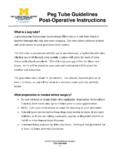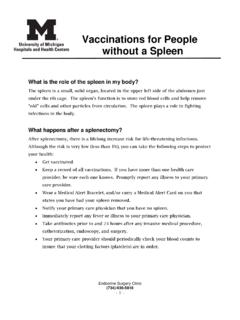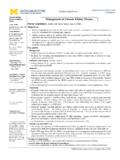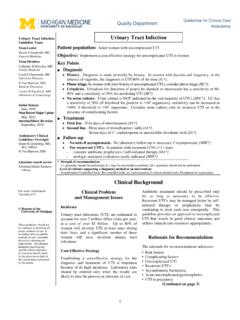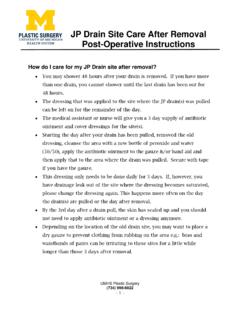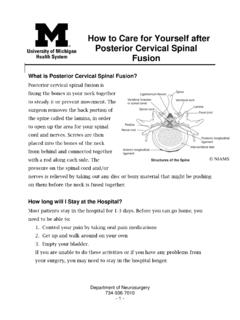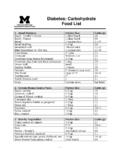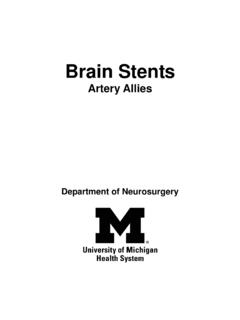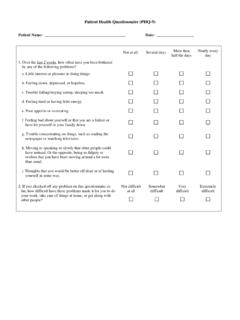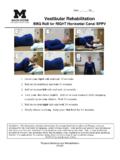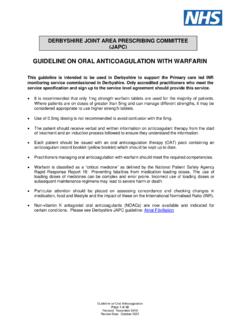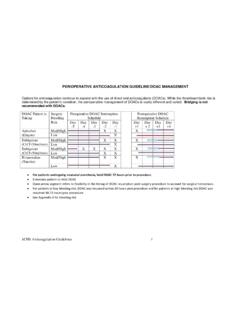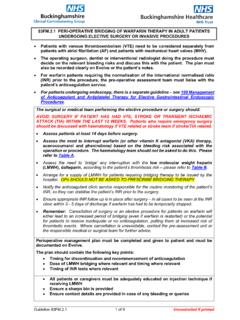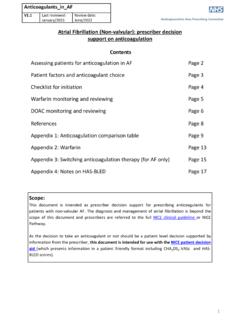Transcription of Inpatient Guideline for Management of Significant Warfarin ...
1 Inpatient Guideline for Management of Significant Warfarin drug - drug interactions with antimicrobial Agents Purpose: The purpose of this Guideline is to provide assistance with dose adjustment of Warfarin when initiating antimicrobial therapy that may affect the INR Recommendations are intended for patients with expected antimicrobial interaction duration 3 days Please document antimicrobial drug - drug interactions in all pharmacy or medication Management notes during the course of the interaction, including expected duration of interaction (if known) antimicrobial agents not included in this document do not directly affect Warfarin metabolism, but may alter normal GI flora and vitamin K production, which can impact INR values.
2 Monitor INR and consider dose reduction in patients with INR increase > within 24 hours or >1 within 48 hours Warfarin dosing should include appropriate assessment of other factors that influence INR (clinical condition, dose of initiated antimicrobial , INR trends, other drug interactions , nutrition, compliance, etc.), and should ultimately be based on the clinical judgment of the provider Table 1. Warfarin Dosing Recommendations for Significant antimicrobial interactions that INCREASE INR: Significant Inhibitors of Warfarin Metabolism INR at Start of antimicrobial Interaction Upon Discontinuation of antimicrobial Interaction Therapeutic INR Subtherapeutic INR* Supratherapeutic INR GTR =Goal therapeutic range Therapeutic INR Metronidazole Empiric Warfarin dose reduction of 20- 30% Give maintenance dose Consider dose reduction in patient with INR increase > within 24hrs or >1 within 48 hrs GTR + ( ): Decrease dose 25-40% GTR + ( ) : Hold dose(s), then 25-50% dose reduction INR >5 and/or bleeding.
3 Hold Warfarin and follow Guideline for reversal of antithrombotic agents if bleeding If patient was on a stable regimen prior to drug interaction, resume previous maintenance dose. Otherwise, empiric dose increase of 20%. Sulfamethoxazole- trimethoprim Fluconazole Itraconazole Ketoconazole Voriconazole Ciprofloxacin Empiric Warfarin dose reduction of 10- 15% Give maintenance dose Consider dose reduction in patient with INR increase > within 24hrs or >1 within 48 hrs within 48 hrs GTR + ( ): Decrease dose 10-15% GTR + ( ) : Hold dose(s), then 10-25% dose reduction INR >5 and/or bleeding: Hold Warfarin and follow Guideline for reversal of antithrombotic agents if bleeding If patient was on a stable regimen prior to drug interaction, resume previous maintenance dose.
4 Otherwise, empiric dose increase of 10%. Clarithromycin Erythromycin Isoniazid * Avoid Warfarin boosting at the start of Warfarin - antimicrobial interaction For sub/supratherapeutic INR at discontinuation: monitor INR closely and adjust as appropriate Consider restarting Warfarin therapy when current INR previous day s INR Page 2 of 4 Table 2. Warfarin Dosing Recommendations for antimicrobial interactions with Potential to INCREASE INR: Mild-Moderate Inhibitors of Warfarin Metabolism INR at Start of antimicrobial Interaction Upon Discontinuation of antimicrobial Interaction Therapeutic INR Subtherapeutic INR Supratherapeutic INR Therapeutic INR Azithromycin No empiric dose reduction. Monitor INR.
5 Consider dose reduction in patient with INR increase > within 24hrs or >1 within 48 hrs If dose was reduced, resume dose from prior to interaction. Doxycycline Levofloxacin Moxifloxacin Quinupristin-dalfopristin Telaprevir Boceprevir Simeprevir For sub/supratherapeutic INR at discontinuation: monitor INR closely and adjust as appropriate Table 3. Warfarin Dosing Recommendations for antimicrobial interactions that DECREASE INR: Inducers of Warfarin Metabolism INR at Start of antimicrobial Interaction Upon Discontinuation of antimicrobial Interaction Therapeutic INR Subtherapeutic INR Supratherapeutic INR GTR =Goal therapeutic range Therapeutic INR Nafcillin/Oxacillin Empiric dose increase of 25- 50% starting 3- 5 days post initiation of nafcillin Increase dose by 30-50% of expected maintenance dose GTR + ( ): Give expected maintenance dose GTR + ( ) : Hold dose(s), then 10% dose reduction INR >5 and/or bleeding.
6 Hold Warfarin and follow Guideline for reversal of antithrombotic agents if bleeding If patient was on a stable regimen prior to drug interaction, resume previous maintenance dose. Otherwise, monitor INR and adjust as needed. Rifampin Rifabutin Empiric dose increase of 20- 30% starting 3- 5 days post initiation of rifampin or rifabutin Increase dose by 20-30% of expected maintenance dose Ritonavir or any protease inhibitor for HIV with ritonavir Monitor INR closely, especially at initiation No empiric dose increase. Adjust Warfarin dose as appropriate by INR For sub/supratherapeutic INR at discontinuation: monitor INR closely and adjust as appropriate Consider restarting Warfarin therapy when current INR previous day s INR Page 3 of 4 References: 1.
7 Ahmed A, Stephens JC, Kaus CA, Fay WP. Impact of preemptive Warfarin dose reduction on anticoagulation after initiation of trimethoprim- sulfamethoxazole or levofloxacin. J Thromb Thrombolysis 2008;26(1):44-8. 2. Gage BF, Fihn SD, White RH. Management and dosing of Warfarin therapy. Am J Med 2000;109(6):481-8. 3. Glasheen JJ, Prochazka AV. The safety of levofloxacin in patients on Warfarin . Am J Med 2007;120(4):e13; author reply e15-6. 4. Baillargeon J, Holmes HM, Lin YL, Raji MA, Sharma G, Kuo YF. Concurrent use of Warfarin and antibiotics and the risk of bleeding in older adults. Am J Med 2012;125(2):183-9. 5. Lane MA, Zeringue A, McDonald JR. Serious bleeding events due to Warfarin and antibiotic co-prescription in a cohort of veterans.
8 Am J Med 2014;127(7):657-663 e2. 6. Dowd MB, Kippes KA, Witt DM, Delate T, Martinez K. A randomized controlled trial of empiric Warfarin dose reduction with the initiation of doxycycline therapy. Thromb Res 2012;130(2):152-6. 7. Mergenhagen KA, Olbrych PM, Mattappallil A, Krajewski MP, Ott MC. Effect of azithromycin on anticoagulation-related outcomes in geriatric patients receiving Warfarin . Clin Ther 2013;35(4):425-30. 8. Hirsh J, Fuster V, Ansell J, Halperin JL. American Heart Association/American College of Cardiology Foundation guide to Warfarin therapy. Circulation 2003;107(12):1692-711. 9. Weinberg AD, Altman JS, Pals JK. Quality improvement case study: Warfarin sodium interactions . J Am Med Dir Assoc 2006;7(5):315-8.
9 10. Fischer HD, Juurlink DN, Mamdani MM, Kopp A, Laupacis A. Hemorrhage during Warfarin therapy associated with cotrimoxazole and other urinary tract anti-infective agents: a population-based study. Arch Intern Med 2010;170(7):617-21. 11. Hines LE, Murphy JE. Potentially harmful drug - drug interactions in the elderly: a review. Am J Geriatr Pharmacother 2011;9(6):364-77. 12. Schelleman H, Bilker WB, Brensinger CM, Han X, Kimmel SE, Hennessy S. Warfarin with fluoroquinolones, sulfonamides, or azole antifungals: interactions and the risk of hospitalization for gastrointestinal bleeding. Clin Pharmacol Ther 2008;84(5):581-8. 13. Ghaswalla PK, Harpe SE, Tassone D, Slattum PW. Warfarin -antibiotic interactions in older adults of an outpatient anticoagulation clinic.
10 Am J Geriatr Pharmacother 2012;10(6):352-60. 14. Ho JM, Juurlink DN. Considerations when prescribing trimethoprim-sulfamethoxazole. CMAJ 2011;183(16):1851-8. 15. Vadlamudi RS, Smalligan RD, Ismail HM. Interaction between Warfarin and levofloxacin: case series. South Med J 2007;100(7):720-4. 16. Clark TR, Burns S. Elevated international normalized ratio values associated with concomitant use of Warfarin and ceftriaxone. Am J Health Syst Pharm 2011;68(17):1603-5. 17. Rice PJ, Perry RJ, Afzal Z, Stockley IH. Antibacterial prescribing and Warfarin : a review. Br Dent J 2003;194(8):411-5. 18. Krajewski KC. Inability to achieve a therapeutic INR value while on concurrent Warfarin and rifampin. J Clin Pharmacol 2010;50(6):710-3.
